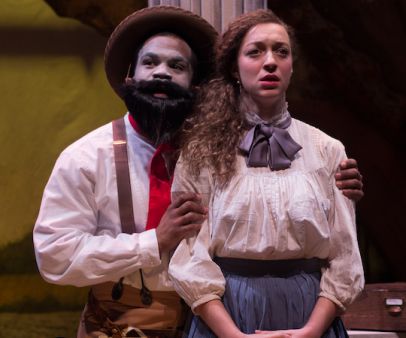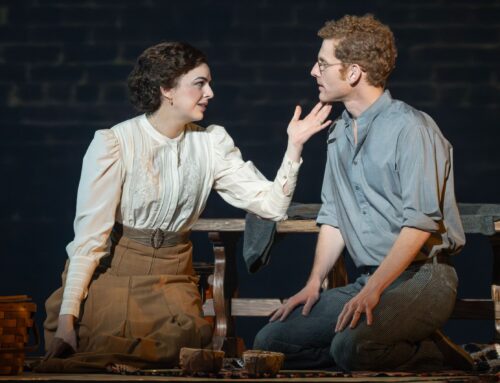 AN OCTOROON co-presented by Company One Theatre and Arts Emerson is smart, sassy, devastating “play-within- a-play”making, which begins with a black playwright casually putting on white face, and speaking directly to us through the layers. The central questions– what it is to be black, to be white, to be any color in between, what those designations have to do with identity and anyone’s place in the culture–are front and center.
AN OCTOROON co-presented by Company One Theatre and Arts Emerson is smart, sassy, devastating “play-within- a-play”making, which begins with a black playwright casually putting on white face, and speaking directly to us through the layers. The central questions– what it is to be black, to be white, to be any color in between, what those designations have to do with identity and anyone’s place in the culture–are front and center.
This material began as a novel written by Thomas Mayne Reid in 1856 called “The Quadroon” a reference to someone who is 1/4 black. A few years later in 1859, playwright Dion Boucicault halved the calculation and doubled the drama creating THE OCTOROON, a play about a beautiful woman named Zoe (the touching Shawna M. James) who is 1/8 black and the illegitimate daughter of the plantation owner. She is the catalyst for this melodrama about slavery and race on a plantation called Terrebonne where she is caught in a struggle between 2 white men attempting to claim her.
Now in the 21st century playwright Branden Jacobs-Jenkins goes at “the Black question” again, the plot’s intransigent themes still very much at issue, only now bracketed by the sophistication of a culture which trafficks in “color-blind casting” and feels it knows better; the issues are even more insidious because of that smugness and the playwright is having none of it.
He lays it all out there–white men in black face, black men in white face, Irish men as red men, and so on until we get to the “octoroon” herself whose fate–the function of an idiotic calculation–is sealed. Through this lens we once again look at race and the senselessness of separating people by “color” into indelible, incontrovertible categories used as weapons in an arsenal of endless bigotry.
But is it enough to merely look? Jacobs-Jenkins wants us to think, know, feel. He lures us in at first and we find ourselves laughing with the company who appear to have fun with the melodrama and all the stereotypes, poking at the cringeworthy condescension embedded in the text (likely unbeknownst to the playwright who may have authored with the best of intentions, but unaware that his prejudices would become fodder for the darker satire of a later era.)
The ensemble clicks, especially Brandon Green in a triple role as the playwright plus dueling protagonists George the “good” plantation owner and M’Closkey the evil slave owner. At one point Green, a black actor in white face, ironically fights himself in opposing roles! Obehi Janice is over the top funny as the feisty house slave Dido along with her best pal fashion-conscious Minnie played by Elle Borders; they along with Amelia Lumpkin as the ever impregnated field hand Grace form a savvy chorus of women in the slave hierarchy, commenting on the goings on between the “massa” and the southern belle Dora in hot pursuit of him. Bridgette Hayes plays Dora like Elizabeth Taylor in heat.
The only character that didn’t work for me was big ole Br’er Rabbit with nasty looking teeth, a trickster of African folklore, high tailing it in and out of scene after scene, but to baffling effect. His presence proved a challenge to director Summer L. Williams who otherwise manages the shifting tones, time frames, plot contrivances, points of view, and layers of reality with ease. Leave the bunny out.
The play is adapted with Boucicault’s plot holes intact; at its climax, a trial is settled by the sudden and improbable appearance of forensic evidence, deus ex “camera” if you will. (Photographic images are pivotal to another of Jacobs-Jenkins plays seen here recently, APPROPRIATE). This evidence leads to the abrupt presentation of horrifying crimes documented in their future and our past; it was a jolt of realism that silenced the audience. Contextualized this way, the images feel even more potent than anything you might casually google in a world where images are easily obtainable and manipulated. In the context of Jacobs-Jenkins play these images retain their stark, incontrovertible truth, packing the punch of the “new technology” of photography when it first appeared.
The final scene places us in a realistic world, outside a naturalistic log cabin and slave quarters. Gone are the flimsy scrims with their painted backdrops of the earlier acts. Gone is the canned music to cue our emotions, strains of “Tainted Love” or the overwrought pipe organ associated with penny dreadfuls. Instead, the cast intones a sorrowful hymn as the light dims around the final lingering questions. How can we be happy in this world? How do we deal with suffering over which we have no control?
It’s worth noting that when the play first appeared in the 19th century here and abroad, it had a happy ending in England, but the new young country on the precipice of Civil War was not ready for mixed race marriage. It would seem that in the 21st century, these United States still have plenty of growing up to do.






[…] Joyce Kulhawik reviews AN OCTOROON […]